Topics
Category
Era
Camp Ripley
Camp Ripley, a state-owned military reservation in central Minnesota, serves as the primary field training site for the Minnesota Army National Guard. It is one of the largest such installations in the country.
After World War I, it was clear that Minnesota needed a better camp for its National Guard. Camp Lakeview, the Guard’s campsite near Lake City, was much too small. The new camp had to be suitable for large bodies of troops, tactical maneuvers, and artillery ranges. In 1929, Minnesota’s adjutant general, Ellard Walsh, announced that such a place had been found: nearly 13,000 acres northwest of Little Falls on the west side of the Mississippi River. The U.S. War Department gave its approval and the Minnesota legislature agreed to purchase the necessary parcels. The site would be called Camp Ripley, after old Fort Ripley, an abandoned nineteenth-century army post that, by coincidence, was located on the property.
Construction began in 1930. When the first troops arrived in June 1931, they were greeted by a water tower and a few buildings. By 1940, the post boasted an infrastructure capable of supporting up to 12,000 troops at one time during summer months. The federal Public Works Administration and its successor programs funded nearly all initial construction.
Additional acreage was acquired in later years, bringing the reservation to 53,000 acres in 1961. Development of field training areas has been continuous since the post opened. There are numerous firing, tank, and gunnery ranges, specialized training areas for a wide variety of combat readiness skills, two aircraft runways, 6,000 feet of railway, and more than 250 miles of trails and roads.
The post has always been important to the U.S. Army. Soldiers used it for large-scale field maneuvers in 1937 and 1940. When World War II broke out, it became a federal Army Service Force installation. From July 1942 to October 1943, thousands of troops received basic and advanced training at Camp Ripley. In the summer of 1943, the post also held a 250-bed tent hospital—the only one of its kind in the nation. The camp’s facilities, however, had not been built for Minnesota’s cold, snowy winters, and the army moved out in October 1943. Shortly thereafter, the post was returned to state control.
Camp Ripley was initially designed as a summer-only post. Soldiers slept under canvas. Corrugated aluminum "hutments" gradually replaced tents in the 1960s. In the 1970s, crews began to build year-round barracks to accommodate winter training. A vigorous building and renovation program has been underway ever since, transforming Camp Ripley into a more diversified, state-of-the-art, year-round training and education facility for use by all branches of service and other government entities as well. Agencies such as the Minnesota Highway Patrol have always made use of Camp Ripley, but especially since the post was winterized.
Terrorist attacks on September 11, 2001, led to enhanced homeland security measures and increased U.S. military involvement in the Middle East. Training emphasis at Camp Ripley followed suit. New construction since 9/11 has produced a 26-building simulated “village” to support tactical training in close-quarter, urban settings; Improvised Explosive Device (IED) training lanes; a Medical Simulation Training Center for medics and civilian responders; an unmanned aerial systems (drones) facility; and a State Emergency Management Training Center. By 2015, the post’s infrastructure could fully support collective, combined arms training for large-scale federal, state, and local civilian emergency management. The camp could easily house up to 4,000 personnel at the same time during winter months.
From its inception, Camp Ripley was designated as a state forest preserve and game refuge. Long committed to environmentally sound stewardship, the camp is a showcase for eco-friendly efforts and use of solar energy. The post supports several environmental initiatives in partnership with Minnesota’s Department of Natural Resources (DNR) and other agencies and organizations. The DNR trains its conservation officers at Camp Ripley.
Bibliography
Abbreviated History of Camp Ripley, National Guard Training Site. [MN]: Minnesota National Guard, 1975.
Bettenburg, Philip C., and Ernest B. Miller. “History and Development of Camp Ripley, Minnesota Military Reservation.” Military Engineer 28, no. 158 (March–April 1936): 129–131.
Geraci, Pauline. “Camp Ripley Program Receives Award.” Brainerd Daily Dispatch, April 18, 1999.
Heilbrun, Captain Robert M. Camp Ripley as a Federal Camp. [MN: N.p., 1943].
“History of the 960th Air Base Security Battalion, 1940–[19]43.” Unpublished manuscript in Minnesota Military Museum Archives, 1943.
Minnesota National Guard. Camp Ripley Training Center.
https://minnesotanationalguard.ng.mil/crtc/
Moeglein, Major General Chester J. “Memoirs.” Unpublished manuscript in Minnesota Museum Archives, 1977.
Ripley Reporter, various issues, 1988.
Description: Newspaper published annually for troops training at Camp Ripley.
“Salute to Camp Ripley.”Little Falls Daily Transcript, June 5, 1964, Souvenir edition.
“U.S. Grants $100,000 in WPA Funds for Ripley Improvement.” Minneapolis Star Journal, August 16, 1940.
Walsh, Ellard A. “Report to the Minnesota State Legislature Covering The Several Activities of the Department of Military and Naval Affairs for the Period July 1, 1940 to November 30, 1942.” Adjutant General’s Office, Minnesota Department of Military and Naval Affairs, December 1, 1942.
“We Say Farewell.” Camp Ripley Muzzle Blast 2, no. 9 (September 22, 1943).
Related Resources
Primary
Camp Ripley Files, 1930–1943
Minnesota Office of the Adjutant General
State Archives Collection, Minnesota Historical Society, St. Paul
Description: Memoranda, extracts, orders, circulars, newsletters, correspondence, building specifications, and blueprints for the state arsenal and other facilities at Camp Ripley, Little Falls, Minnesota.
Secondary
Camp Ripley, Little Falls, Minn., 1937. Minneapolis: Moses Bloom, 1937.
Camp Ripley: A Premier Winter Training Site. [Camp Ripley, MN: Public Affairs Office, 1990].
Erikson, Sandra Alcott. Camp Ripley: 1930–1960. Charleston, SC: Arcadia Publishing, 2007.
Facilities Management Office, Camp Ripley. Department of Military Affairs Education and Training Center, Camp Ripley. Camp Ripley, MN: Facilities Management Office, [1988?].
Kunz, Virginia Brainard. Muskets to Missiles: A Military History of Minnesota. St. Paul: Minnesota Statehood Centennial Commission, 1958.
Nuerhring, Lisa L. "Camp Ripley 1937–45." Master’s thesis, St Cloud State University, May 1998.
Welcome to Camp Ripley: Little Falls, Minnesota. [Little Falls, MN: Camp Ripley, 1998?].
Web
Johnson, Jack K. “A Brief History of Camp Ripley.”
http://www.mnmilitarymuseum.org/resources/mn-military-history/camp-ripley/
Related Images
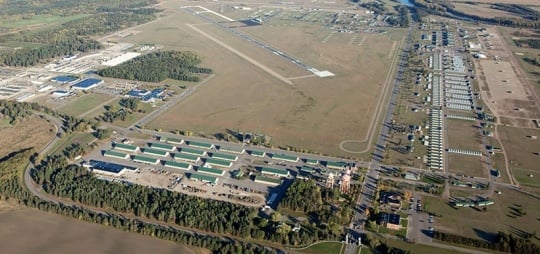
Camp Ripley cantonment area
Holding Location
Articles
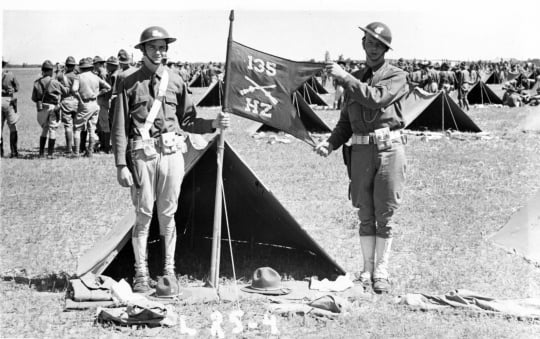
Moe Jones and Einar Lund during a field inspection at Camp Ripley
Holding Location
Articles
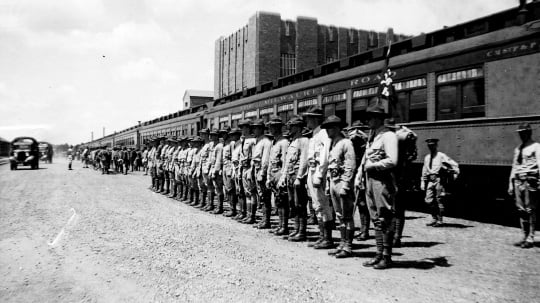
Guardsmen arrive by train for training at Camp Ripley
Holding Location
Articles
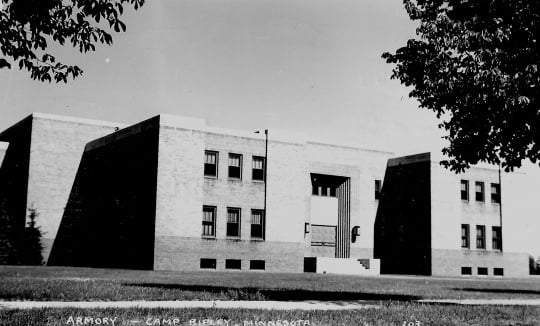
Camp Ripley’s first armory
Holding Location
Articles

Aircraft hanger at Camp Ripley
The aircraft hanger, shown here in a 1939 photo, was built in 1932 and served as home for the 109th Observation Squadron when it trained at Camp Ripley. In the forefront are two Douglas O-38 biplanes; a North American O-47 monoplane peeks out from the hanger.
Holding Location
Articles
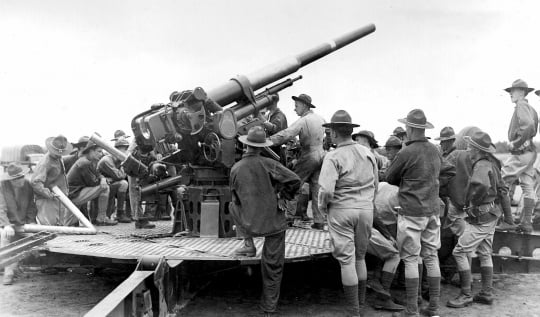
Soldiers of the 215th Coast Artillery Regiment at Camp Ripley
Holding Location
Articles
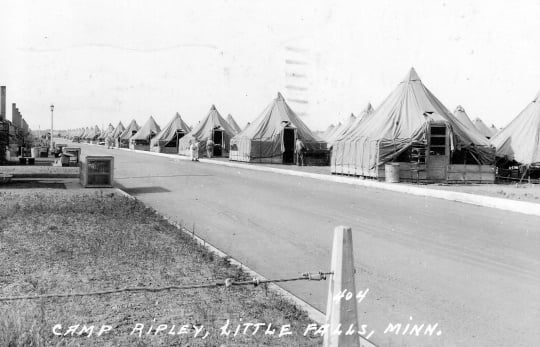
A tent city at Camp Ripley
Holding Location
Articles
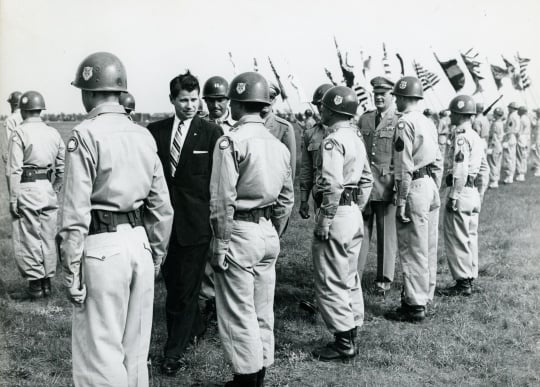
Governor Orville Freeman inspecting troops at Camp Ripley
Holding Location
Articles
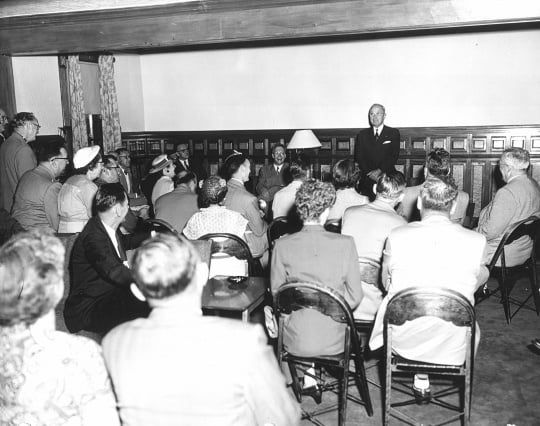
Former president Harry Truman speaking at Camp Ripley
Holding Location
Articles
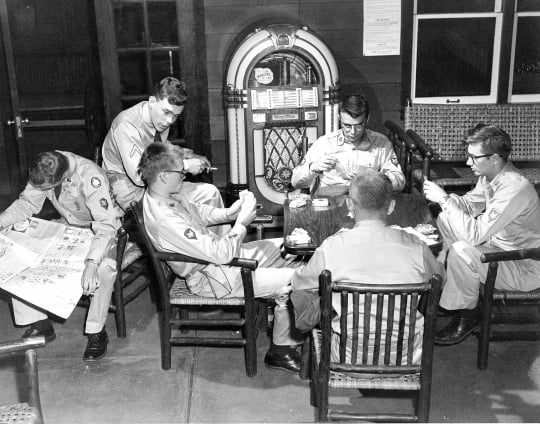
After-hours relaxation in Camp Ripley’s Enlisted Service Club
Holding Location
Articles
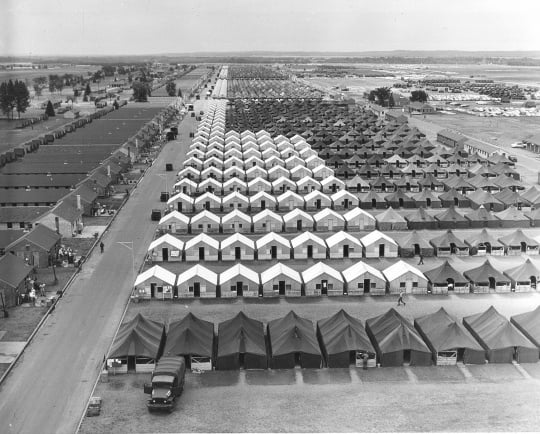
Conversion of tents to "hutments" at Camp Ripley
This image, taken in 1965, illustrates the replacement of tents with aluminum “hutments” (soldiers referred to them as tin huts) in the 1960s. The conversion took five years.
Holding Location
Articles
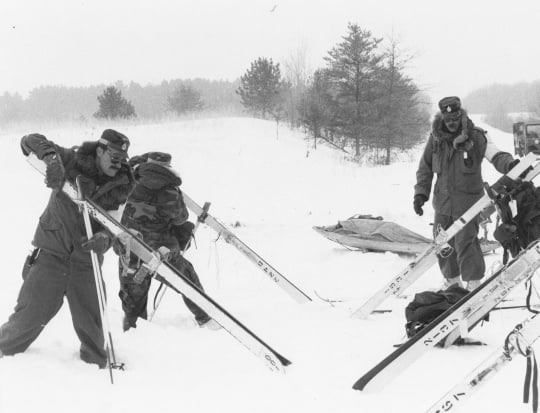
Winter operations training at Camp Ripley
Holding Location
Articles

M1 Abrams tanks arrive at Camp Ripley on flatcars
Holding Location
Articles
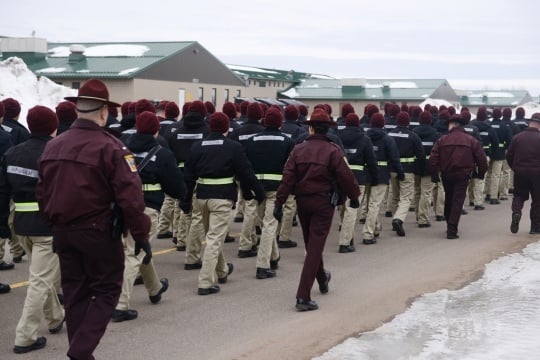
Cadre and candidates of the Minnesota State Patrol’s Trooper Academy at Camp Ripley
Holding Location
Articles

Platoon of the 34th Military Police Company, 34th Infantry Division, at Camp Ripley
All rights reserved
Holding Location
Articles
Related Articles
Turning Point
In 1973, workers begin constructing self-contained buildings at Camp Ripley that can each house and feed a company of 200 soldiers in the winter months. This marks the beginning of the post’s transformation from a summer-only field training camp to a larger, year-round education and training facility capable of serving a broader variety of needs.
Chronology
1929
1931
1940
1942
1944
1947
1961
1974
mid-1970s
1980
1988
2003
2016
2016
Bibliography
Abbreviated History of Camp Ripley, National Guard Training Site. [MN]: Minnesota National Guard, 1975.
Bettenburg, Philip C., and Ernest B. Miller. “History and Development of Camp Ripley, Minnesota Military Reservation.” Military Engineer 28, no. 158 (March–April 1936): 129–131.
Geraci, Pauline. “Camp Ripley Program Receives Award.” Brainerd Daily Dispatch, April 18, 1999.
Heilbrun, Captain Robert M. Camp Ripley as a Federal Camp. [MN: N.p., 1943].
“History of the 960th Air Base Security Battalion, 1940–[19]43.” Unpublished manuscript in Minnesota Military Museum Archives, 1943.
Minnesota National Guard. Camp Ripley Training Center.
https://minnesotanationalguard.ng.mil/crtc/
Moeglein, Major General Chester J. “Memoirs.” Unpublished manuscript in Minnesota Museum Archives, 1977.
Ripley Reporter, various issues, 1988.
Description: Newspaper published annually for troops training at Camp Ripley.
“Salute to Camp Ripley.”Little Falls Daily Transcript, June 5, 1964, Souvenir edition.
“U.S. Grants $100,000 in WPA Funds for Ripley Improvement.” Minneapolis Star Journal, August 16, 1940.
Walsh, Ellard A. “Report to the Minnesota State Legislature Covering The Several Activities of the Department of Military and Naval Affairs for the Period July 1, 1940 to November 30, 1942.” Adjutant General’s Office, Minnesota Department of Military and Naval Affairs, December 1, 1942.
“We Say Farewell.” Camp Ripley Muzzle Blast 2, no. 9 (September 22, 1943).
Related Resources
Primary
Camp Ripley Files, 1930–1943
Minnesota Office of the Adjutant General
State Archives Collection, Minnesota Historical Society, St. Paul
Description: Memoranda, extracts, orders, circulars, newsletters, correspondence, building specifications, and blueprints for the state arsenal and other facilities at Camp Ripley, Little Falls, Minnesota.
Secondary
Camp Ripley, Little Falls, Minn., 1937. Minneapolis: Moses Bloom, 1937.
Camp Ripley: A Premier Winter Training Site. [Camp Ripley, MN: Public Affairs Office, 1990].
Erikson, Sandra Alcott. Camp Ripley: 1930–1960. Charleston, SC: Arcadia Publishing, 2007.
Facilities Management Office, Camp Ripley. Department of Military Affairs Education and Training Center, Camp Ripley. Camp Ripley, MN: Facilities Management Office, [1988?].
Kunz, Virginia Brainard. Muskets to Missiles: A Military History of Minnesota. St. Paul: Minnesota Statehood Centennial Commission, 1958.
Nuerhring, Lisa L. "Camp Ripley 1937–45." Master’s thesis, St Cloud State University, May 1998.
Welcome to Camp Ripley: Little Falls, Minnesota. [Little Falls, MN: Camp Ripley, 1998?].
Web
Johnson, Jack K. “A Brief History of Camp Ripley.”
http://www.mnmilitarymuseum.org/resources/mn-military-history/camp-ripley/
















